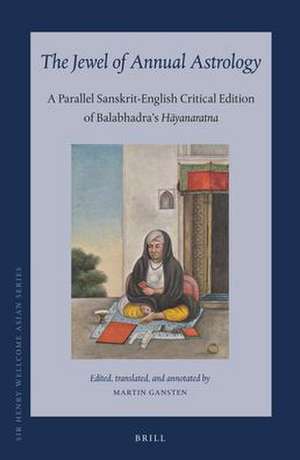The Jewel of Annual Astrology: A Parallel Sanskrit-English Critical Edition of Balabhadra’s Hāyanaratna: Sir Henry Wellcome Asian Series, cartea 19
Autor Martin Gansten, Balabhadra Daivajñaen Limba Engleză Hardback – 5 aug 2020
The Jewel of Annual Astrology is an encyclopaedic treatise on Tājika or Sanskritized Perso-Arabic astrology, dealing particularly with the casting and interpretation of anniversary horoscopes. Authored in 1649 CE by Balabhadra Daivajña, court astrologer to Shāh Shujāʿ – governor of Bengal and second son of the Mughal emperor Shāh Jahān – it casts light on the historical development of the Tājika school by extensive quotations from earlier works spanning five centuries.
With this first-ever scholarly edition and translation of a Tājika text, Martin Gansten makes a significant contribution not only to the study of an important but little known knowledge tradition, but also to the intellectual historiography of Asia and the transmission of horoscopic astrology in the medieval and early modern periods.
Preț: 438.02 lei
Preț vechi: 515.32 lei
-15% Nou
83.81€ • 91.33$ • 70.63£
Carte indisponibilă temporar
Specificații
ISBN-10: 9004426655
Dimensiuni: 155 x 235 mm
Greutate: 0 kg
Editura: Brill
Colecția Brill
Seria Sir Henry Wellcome Asian Series
Notă biografică
Martin Gansten, Ph.D. (2003), Lund University, is a Sanskritist and historian of religion specializing in Indic religions as well as the global transmission history of horoscopic astrology.
Cuprins
Preface
Introduction
Text and Translation
1 Fundamentals of Astrology and the Annual Revolution
1.1 The Author’s Family Lineage
1.2 The Tājika Teaching: Lawful and Useful
1.3 Fate, Human Effort, and the Astrologer
1.4 The Signs of the Zodiac
1.5 The Planets
1.6 Calculating the Time of the Annual Revolution
1.7 General Methods for Gauging the Nature of the Year
1.8 Calculating the Planetary Positions in the Annual Revolution
1.9 Calculating and Judging the Houses in the Annual Revolution
2 Aspects and Dignities
2.1 The Various Aspects and Their Results
2.2 Dexter and Sinister Aspects
2.3 Numerical Values of the Aspects
2.4 Schemes of Friendship and Enmity
2.5 The Five Dignities
2.6 The Sixfold Strength
2.7 Other Calculations of Strength
2.8 The Twelve Dignities
2.9 The Joys of the Planets
3 The Sixteen Configurations
3.1 The Names of the Configurations and the Orbs of Light of the Planets
3.2 The ikkavāla and induvāra Configurations
3.3 The itthaśāla Configuration
3.4 The īsarāpha Configuration
3.5 The nakta Configuration
3.6 The yamayā Configuration
3.7 The maṇaū Configuration
3.8 The kambūla Configuration
3.9 The gairikambūla Configuration
3.10 The khallāsara Configuration
3.11 The radda Configuration
3.12 The duḥphālikuttha Configuration
3.13 The dutthotthadabīra Configuration
3.14 The tambīra Configuration
3.15 The kuttha Configuration
3.16 The duruḥpha Configuration
4 The sahamas
4.1 The Names of the sahamas
4.2 Calculating the sahama of Fortune: Conflicting Opinions
4.3 Calculating the Remaining sahamas
4.4 Converting the sahamas to Ascensions
4.5 Sahamas of Signs, Planets, and Family Members
4.6 The Results of sahamas
4.7 The Times of Results
5 The Ruler of the Year and Related Matters
5.1 Calculating the munthahā
5.2 General Results of the munthahā
5.3 Results of the munthahā Occupying the Twelve Houses
5.4 The munthahā in the Nativity and in the Revolution
5.5 Planets Influencing the munthahā
5.6 Finding the munthahā from a Query
5.7 The Triplicity Rulers
5.8 Finding the Ruler of the Year
5.9 Special Considerations
5.10 General Results of the Ruler of the Year
5.11 The Results of Each Planet as Ruler of the Year
5.12 Unfortunate Configurations
5.13 Cancellation of Misfortune
5.14 Configurations for Dominion
5.15 Cancellation of Dominion
6 Judging the Twelve Houses
6.1 General Principles of Judgement
6.2 The First House
6.3 The Second House
6.4 The Third House
6.5 The Fourth House
6.6 The Fifth House
6.7 The Sixth House
6.8 The Seventh House
6.9 The Eighth House
6.10 The Ninth House
6.11 The Tenth House
6.12 The Eleventh House
6.13 The Twelfth House
7 The Planetary Periods
7.1 The Periods Based on Deducted Degrees
7.2 Including or Excluding the Signs: Different Opinions
7.3 Three Varieties of tāsīra Periods
7.4 The Periods Based on Planetary Hours
7.5 The haddā Periods
7.6 The Natural Periods of the Planets
7.7 The Results of Periods
7.8 The Subperiods of the Planets
7.9 Periods according to the Schools of Gaurī and Mahādeva
7.10 Periods according to the School of (Bala)rāma
7.11 The Use of the Different Systems of Periods
8 Monthly and Daily Revolutions
8.1 Preliminary Calculations
8.2 The Three Corrections
8.3 An Example from the Nativity of Shāh Shujāʿ
8.4 The Ruler of the Month and Results according to the Ninth-Parts
8.5 The Planets in the Ninth-Parts of the Houses
8.6 The Planets in the Houses
8.7 The Results of Periods within a Month
8.8 The Results of Daily Revolutions
8.9 The Ruler of the Day and Other Planets
8.10 Periods within a Day
8.11 Planetary States in the Daily Revolution
8.12 The Judgement of Meals
8.13 The Judgement of Hunting
8.14 The Judgement of Dreams
8.15 How to Write out a Complete Annual Horoscope
8.16 Dedication and Conclusion
Appendix: Solar Equation (mandaphala)
Glossary of Astrological Terms
Bibliography
Index













